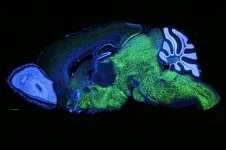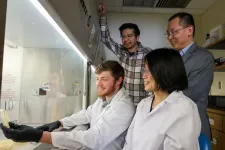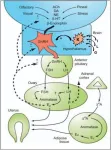(Press-News.org) The immune systems of cancer patients are highly disrupted, with those who have a higher number of immune cells in their blood having a better survival rate, finds a new study that uses a pioneering technique developed by researchers at UCL and the Francis Crick Institute.
The tool, described in Nature Genetics, is called Immune Lymphocyte Estimation from Nucleotide Sequencing (ImmuneLENS). It enables researchers to calculate the proportion of T cells and B cells (types of immune cell) from whole genome sequencing (WGS) data for the first time.
Whole genome sequencing (WGS) uses a blood sample to create a complete record of an individual’s DNA, the genetic instructions that determine who they are. By understanding these instructions, scientists can find out important information such as how many immune cells a person has, if there are any changes in their genes, and how their body is combating disease. This can be helpful for studying genetic illnesses such as cancer.
The team used ImmuneLENS to analyse over 90,000 WGS samples from the 100,000 Genomes Project, a study led by Genomics England and NHS England, which included the genomes of healthy individuals and cancer patients.
They found that cancer patients had a lower proportion of T cells circulating in the blood compared to healthy individuals. Further, T cell proportion was found to be a strong predictor of cancer outcomes, with higher proportions associated with 47% fewer deaths over a five-year period after surgery. This effect was still significant when accounting for age, cancer stage and across all cancer types1.
The team say that these biological markers could be easily added to current genetic diagnostic tests, which would provide clinicians with more information on which to base treatment plans.
Professor Nicholas McGranahan, senior author of the study from UCL Cancer Institute, said: “Most immune system analysis until now has focused on the tumour itself, so the results we’re seeing using this new technique – which examines the number of immune cells in a person’s blood – are of considerable interest. What’s going on with immune cells in the blood seems to have a huge impact on cancer survival and may be able to predict how long a cancer patient will survive better than the number of T cells in the tumour alone.
“There have been hints in previous research that this might be important, but being able to analyse immune system information at this scale is game changing. The ability to compare immune cell changes in the blood and to what’s happening in the tumour environment opens up new avenues for cancer research, as well as healthcare research more widely.
“In terms of patient diagnosis and treatment, knowing whether a patient has relatively high or low numbers of immune cells in the blood, and how this corresponds to their prognosis, could help clinicians to decide on the best course of treatment for the individual.”
Cancer is a disease primarily caused by genetic mutations in the body’s cells, with certain mutations associated with particular types of cancer. While immune cells can recognise and eliminate dangerous mutations, cancer often evades this response and disrupts the immune system.
As such, assessing changes in both the area round the tumour (local immune environment) and in the wider immune system is crucial for understanding how cancer develops and predicting how a patient might respond to treatment.
Large-scale initiatives like the 100,000 Genomes Project, which holds whole genome data collected from over 90,000 NHS patients affected by rare disease or cancer, have allowed researchers to see the full spectrum of genetic changes within healthy and cancer cells. But the understanding of the precise immune cell makeup within both the tumour and wider immune environment hasn’t been possible until now.
ImmuneLENS builds on a previous method from 2021 that enabled the proportion of T cells in whole exome sequencing data to be calculated.
While it is known that in healthy individuals the proportion of immune cells in the blood diminishes with age, the team found that this happens sooner in people with cancer.
This effect was more pronounced in male than female cancer patients, but it is not clear why these sexual differences exist or whether it has an influence on overall cancer survival.
They also observed that individuals who were seemingly healthy at the time their sample was taken for sequencing, who subsequently went on to develop cancer, had below average levels of B cells in their blood. This could be because of undiagnosed early-stage cancer, or pre-cancerous changes to the immune system that could potentially have been an early sign of disease or even a factor in cancer developing.
This information could be used in future for cancer early detection or to help clinicians understand how the patient may respond to treatment.
Dr Robert Bentham, first author of the study from UCL Cancer Institute, said: “Lots of approaches that measure immune cells from genetic data are like looking for a needle in a haystack. Our approach in this study instead looks at the haystack itself and asks how the presence of immune cells changes its overall shape. It’s a different, more efficient way of finding the needle.
“One of the things this will allow us to do is to build significant immune datasets using data we already have from the many large-scale WGS cohorts but haven’t been able to interrogate until now. It will allow researchers to explore what’s happening in the immune system during health and disease, not just in cancer but potentially in many areas of medicine.”
This method also allows different types of B cells to be easily distinguished from one another. As B cells mature, they specialise to produce a certain type of antibody (a protein whose role is to neutralise harmful substances such as viruses, bacteria and mutated cells). The team used this specialisation process to identify B cells and classify them.
When this method was applied to WGS data it revealed that B cells producing IgM/D antibodies in the blood (produced when the body first encounters a foreign antigen) were the only type of B cell associated with improved survival outcomes of cancer patients, suggesting that these cells may play a key role in anti-tumour immunity. They also have potential as a new biological marker for cancer diagnosis, making them a promising target for future research.
One of the next steps for the researchers will be to take advantage of these biological markers in the clinic, which they say could be added to the current battery of tests for cancer patients at no extra cost. Professor McGranahan and his team have recently received started a CRUK funded Biomarker Project Award to enable further work to translate this into the clinic.
This could be particularly useful for predicting a patient’s response to immunotherapy, because while the proportion of T cells in a tumour is a known biomarker it cannot be measured using current standard genomic tests.
Research Information Manager at Cancer Research UK, Dr Nisharnthi Duggan, said: “Cancer Research UK is pleased to support this ongoing work investigating whether measuring immune cell levels in our blood can help predict cancer survival. We're living in a golden age of research where we can use patient data in sophisticated ways to help us better understand cancer and how to beat it.
“Further research is needed, but this could one day become a tool to help doctors personalise treatment for people with cancer.”
The research is part of the Cancer Research UK-funded TRACERx project.
This research was made possible through access to the data and findings generated by the 100,000 Genomes Project, which is managed by Genomics England.
Notes to Editors:
For more information, please contact:
Dr Matt Midgley
+44 (0)20 7679 9064
m.midgley@ucl.ac.uk
1This included all cancer types present within the 100,000 Genomes Project dataset.
Publication:
Robert Bentham etc al. ‘ImmuneLENS characterizes systemic immune dysregulation in aging and cancer’ is published in Nature Genetics and is strictly embargoed until Tuesday 18 February at 10:00 GMT / 05:00 ET.
DOI: https://doi.org/10.1038/s41588-025-02086-5
About UCL – London’s Global University
UCL is a diverse global community of world-class academics, students, industry links, external partners, and alumni. Our powerful collective of individuals and institutions work together to explore new possibilities.
Since 1826, we have championed independent thought by attracting and nurturing the world's best minds. Our community of more than 50,000 students from 150 countries and over 16,000 staff pursues academic excellence, breaks boundaries and makes a positive impact on real world problems.
The Times and Sunday Times University of the Year 2024, we are consistently ranked among the top 10 universities in the world and are one of only a handful of institutions rated as having the strongest academic reputation and the broadest research impact.
We have a progressive and integrated approach to our teaching and research – championing innovation, creativity and cross-disciplinary working. We teach our students how to think, not what to think, and see them as partners, collaborators and contributors.
For almost 200 years, we are proud to have opened higher education to students from a wide range of backgrounds and to change the way we create and share knowledge.
We were the first in England to welcome women to university education and that courageous attitude and disruptive spirit is still alive today. We are UCL.
www.ucl.ac.uk | Follow @uclnews on Bluesky | Read news at www.ucl.ac.uk/news/ | Listen to UCL podcasts on SoundCloud | View images on Flickr | Find out what’s on at UCL Minds
END
New tool reveals disruption of immune cells in blood is linked to cancer outcomes
2025-02-18
ELSE PRESS RELEASES FROM THIS DATE:
Newfound circuit better explains how the brain recognizes what is familiar and important
2025-02-18
*** Embargoed for release until Tuesday, Feb. 18, 2025, at 5 a.m. EST ***
A newly identified part of a brain circuit mixes sensory information, memories, and emotions to tell whether things are familiar or new, and important or just “background noise.”
Led by researchers from NYU Langone Health, the work found that a circuit known to carry messages from a brain region that processes sensory information, the entorhinal cortex (EC), to the memory processing center in the hippocampus (HC) has a previously unrecognized pathway that carries messages directly back to the EC.
Publishing online Feb. 18 in Nature Neuroscience, the study results show that this direct feedback ...
A single protein may have helped shape the emergence of spoken language
2025-02-18
The origins of human language remain mysterious. Are we the only animals truly capable of complex speech? Are Homo sapiens the only hominids who could give detailed directions to a far-off freshwater source or describe the nuanced purples and reds of a dramatic sunset?
Close relatives of ours such as the Neanderthals likely had anatomical features in the throat and ears that could have enabled the speaking and hearing of spoken language, and they share with us a variant of a gene linked to the ability to speak. And yet it is only in modern humans that we find expanded brain regions that are critical for language production and comprehension.
Now researchers from The Rockefeller University ...
Scientists decode diet from stool DNA – no questions asked
2025-02-18
SEATTLE – Scientists have developed a breakthrough method to track diet using stool metagenomic data.
Developed by researchers at the Institute for Systems Biology (ISB), the new method, called MEDI (Metagenomic Estimation of Dietary Intake), detects food-derived DNA in stool samples to estimate dietary intake. MEDI leverages stool metagenomics, which refers to sequencing all the DNA present in fecal samples (including microbial, human, and food-derived DNA). This non-invasive, data-driven approach offers an objective alternative to traditional food diaries and questionnaires, ...
Biologists transform gut bacteria into tiny protein pharmacies
2025-02-18
Hundreds of different species of microbes live, laugh, and love in your gut. In the future, one of these might serve a new function: microscopic in-house pharmacist.
A new study published Feb. 18 in Nature Biotechnology shows how gut bacteria can be directed to produce and release proteins within the lower gastrointestinal tract — eliminating a major roadblock to delivering drugs to that part of the body.
Oral medication is the most common and practical means of drug administration, but the stomach doesn’t let much pass through unscathed. This is good when it comes to things like foodborne ...
Study sheds light on the genetics of stopping smoking
2025-02-18
The effectiveness of a common drug to quit smoking could be down to people’s genes, according to a study from the University of Leicester (United Kingdom).
Varenicline is widely recognised as the most effective medication for helping people stop smoking, but unfortunately it does not work for everyone.
Researchers from Leicester have uncovered important insights into how people’s DNA affects their response to the drug, which will soon be available to smokers through the UK’s National Health Service (NHS).
Varenicline ...
Landmark review maps complex interactions between sex hormones and neurological health
2025-02-18
MONTREAL, Québec, Canada, 18 February 2025 - A comprehensive review published today in Brain Medicine by leading neuroendocrinologist Professor Hyman M. Schipper from McGill University’s Department of Neurology and Neurosurgery maps out the extensive influence of reproductive hormones on neurological health and disease. This landmark review, appearing in a special Festschrift issue honoring Dr. Seymour Reichlin’s centennial, systematically examines how sex hormones affect a broad ...
Restoring African grassland habitats makes life more peaceful for humans and wildlife, scientists find
2025-02-18
Across Kenya, grasslands underpin people’s lives — as well as those of animals like elephants, giraffes, and hyenas. But the climate crisis is drying out these habitats, forcing people and animals to compete for resources, and increasing both community tensions and conflict between humans and wildlife. Researchers monitoring both grassland restoration and conflicts have now found that restoration can help reduce human-wildlife conflict and improve community relations: the more local grassland is restored, the less conflict there is.
“Grassland restoration is playing a role in reducing human-wildlife conflicts, social conflicts and the overall feeling of insecurity ...
Ventilation fans can significantly lower the risk of inhaling bacteria particles after toilet flushing
2025-02-18
Bioaerosol emissions during toilet flushing are an often-overlooked source of potential health risks in shared public facilities. A new study published in Risk Analysis found that bioaerosol concentrations of two bacteria -- Escherichia coli (E. coli) and Staphylococcus aureus (S. aureus) -- exceeded acceptable levels established by the Centers for Disease Control (CDC) after toilet flushing. Inhaling these biological particles can produce symptoms like abdominal cramps, nausea, diarrhea, and vomiting.
The research was conducted in two restrooms located in an office building in China. One contained a squat toilet and the other a bidet toilet. Scientists measured the emissions ...
Legionnaires’ disease from a lake swim
2025-02-18
Swimming in some lakes with still water can lead to infection with Legionella, bacteria that can cause pneumonia, and people who engage in open water swimming should be aware of this risk, say the authors of a practice article published in CMAJ (Canadian Medical Association Journal) https://www.cmaj.ca/lookup/doi/10.1503/cmaj.241086.
“Legionella infection represents a public health hazard owing to its ability to spread through exposure to natural water bodies and human-made water reservoirs,” writes Dr. Ashley Bryson, an internal medicine resident at the University of Manitoba, with coauthors.
Legionella infection is an atypical cause of community-acquired ...
New remotely-delivered support programme could deliver excellent care while saving the NHS and social care an average of £9000 a year for each person with dementia
2025-02-18
UNDER STRICT EMBARGO UNTIL UNDER STRICT EMBARGO UNTIL MONDAY 17 FEBRUARY 2025 AT 23.30 (UK TIME).
Peer reviewed | Randomised Controlled Trial | People
The NIDUS-Family package of care uses goal setting to help people with dementia live well at home for longer. New research from Queen Mary University of London in collaboration with UCL shows that, in addition to these known benefits, NIDUS-Family also reduces the costs associated with providing support to people with dementia.
Approximately ...


